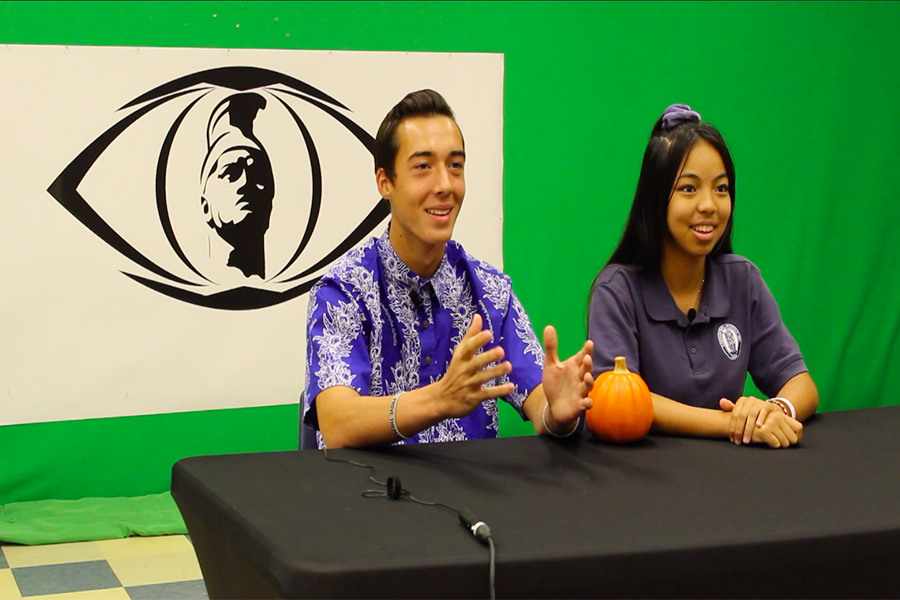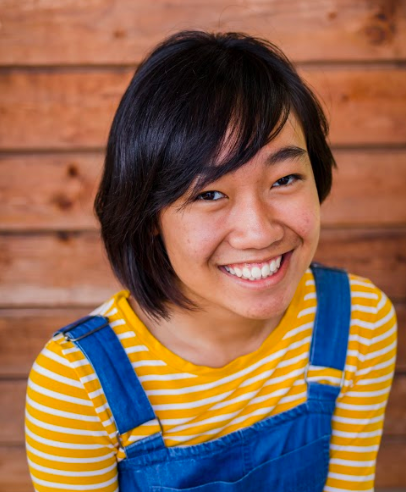Morning broadcast gives students new channel
November 14, 2019
A fresh student-led morning broadcast, Ka Maka Koa, gives students a new way to have a voice.
“Ka Maka Koa gives you that opportunity to try and–whether you’re in the front or in the back–give you some experience. Maybe it’ll spark something else,” adviser Kumu Lōkahi Antonio said. “We wanted something that was not just gonna be the ordinary thing. We want to talk about and show, discuss things that would make you stop and think.”
At the urging and with the input of students, Kumu Lōkahi, teacher Mr. Kaholo Rickard and post-high counselor Ms. Lisa Correa helped create and form the idea of the broadcast. The identity for Ka Maka Koa, meaning “the brave face,” is revealed in their logo, which says “Bold. Fierce. Visionary.”
Kumu Lōkahi said that the words serve as a reminder of the mission and direction of the endeavor.
“Being a part of the broadcast production team should have you thinking outside of your comfort zone, pushing yourself to new places that you didn’t think you could go,” Mr. Rickard said.
Through the extra-curricular program, select students from grades 9-12 who have expressed interest and demonstrated commitment learn about video production, film and broadcasting outside of the school’s media and literary arts endorsements. Many of the students involved have experience from being on the award-winning video production team in the middle school or from their participation in the middle school morning broadcast.
The students and their advisers look at the program not only as an organization that can stand on its own merits, but also as a possible stepping stone into the upper level Nā Koa Media programs, Whatʻs Up Warriors and Ka Leo o Nā Koa, that are currently in place.
“I’ve learned about broadcast in general,” sophomore director Sean “Aimi” Sakamoto said (see related “Lights, Camera, Action”). “Besides that, I’ve learned to think quickly and improvise, but also to be detail-oriented and patient.”
Students take on different positions and roles and deliver segments, both live and recorded, along with the high school daily bulletin announcements. The broadcast begins at 8:20 most mornings on the Ka Maka Koa channel on YouTube. Past episodes are also available there in their archives.
“I like mostly the segments because it’s always interesting…I also like when it says what lunch is because it’s very informing,” junior Tianna Lopez said.
There are many plans for the future of the broadcast.
“I hope that we can continue to evolve the broadcast successfully and effectively with students who are motivated to be a part of a live broadcast environment,” Mr. Rickard said.
Ka Maka Koa has also launch Ka Uila Sports, a sports broadcasting arm, in order to stream live athletic events. So far, Ka Uila has aired one trial broadcast available to a limited audience followed up by a successful livestream of an entire varsity girls volleyball game, complete with commentating and color.
The multi-camera production even included updated scores in the lower third of the screen thanks to the programming talents of sophomore Jaxson Pahukula. Click here to view them in action.
In its first year, the program has been well-received with most students watching every episode, but it also has its critics.
Despite some criticism, the team remains steadfast and optimistic about giving students an opportunity to engage.
Kumu Lōkahi said that the staff is challenged to “just do things out of the ordinary because many times here on campus, it almost seems as if we censor ourselves, that we might not bring up issues that might make us a little uncomfortable.”
Also in the future of the Ka Maka Koa team, said Kumu Lōkahi, is that he “would like us to step out. Not just step out of that proverbial box, but step off of campus too. …We are part of the community.”
Lights, Camera, Action
Meet Sean “Aimi” Sakamoto
Award-winning sophomore Sean “Aimi” Sakamoto is making a name for herself as the heartbeat of the new morning broadcast show Ka Maka Koa.
Only in her second year of high school, Sakamoto already brings years of experience with her. She has competed in the Music Video and Crazy 8s categories at the Student Television Network national conferences in 2017 and 2018. Sakamotoʻs team won second place in 2017 and earned an honorable mention in 2018. The STN Convention is a national and international film conference that includes video production competition events for students.
To compete in the STN music video competition, students are given an original song and three hours to plan and shoot a video for it, with another three hours to edit. Filming outside of a certain area or not completing the video within the six hours results in elimination.
For the Crazy 8s, the KS Maui team was given a prompt, and within eight hours the team had to complete a documentary on it.
While in middle school, Sakamoto was also awarded for her work on Hiki Nō, a student-produced documentary program on PBS.
Additionally, one of Sakamoto’s short films on bullying and suicide, which she made with classmate Haley Mahoe in the eighth grade, was a finalist at ʻŌlelo Community Mediaʻs 15th Annual Youth Xchange Student Video Competition.
While her film, Behind a Smile, did not win at the competition, Sakamoto also submitted it to the STN Nationals short film contest, and her work was awarded first place in the nation in her category, Creative Segment.
This year, Sakamoto added the Ka Maka Koa broadcast to her list of projects.
People may think that video production and broadcast are the same thing, but Sakamoto says otherwise.
“I’ve been working in film for a few years now, but broadcast is a whole different story,” she said.
Sakamoto was drawn to Ka Maka Koa because “I thought it was interesting. It was new, and it had to do with film, so I thought I’d give it a try.”
When Mr. Rickard spoke to her about joining, she said that she had missed working on filming and wasn’t working on anything at the time, so it was a natural fit, and she enjoys “learning more about things that might come in useful later.”
She said she was up for the challenge.
”It’s been an interesting experience because doing things live is very different from what I’m used to do, so I’m trying to figure out how to use what I already know while also learning new things..”
Sakamoto is excited to be on the ground floor of this new outlet for student voices.
“I think a big thing is staying patient and knowing that we’re not going to be as impressive and close to perfect as we’re ever going to be right away while also not settling for things staying the way they are,” she said. “It’s been difficult though fun to figure out.”

